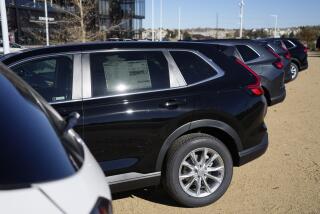First-time buyers want it all, and get it
- Share via
Bare bones.
Plain Jane.
Forget the frills.
Think function -- and lowest possible price.
That’s how first-time buyers used to think when buying a set of wheels -- and how the manufacturers and dealers reacted with the products they offered.
First-time car buyers today expect more.
“Things consumers once perceived as luxury features are now thought of as essentials, such as an AM/FM radio with CD player and six speakers that we offer as standard in our [$12,800] Spectra,” said Fred Aikens, product strategy manager for Rio and Spectra with Kia.
“Try to find a kid in a car without power windows today,” agreed Art Spinella, general manager of CNW Marketing Research, a firm that looks into why people buy the vehicles they do. “You can’t.”
You can thank parents for raising the bar.
“They [first-timers] demand more features and more car for the money because they grew up in their parents’ vehicles,” said Jim Farley, who headed the Scion entry-level division until his promotion this year to vice president of marketing for the Toyota division. “They’ve been in the nice cars mom and dad had, and they expect that in their first car. By taking on more debt, by going to 60- to 72-month financing to bring down the amount of the payments, youth feels it can go bigger and better,” he added.
There are basically three ways for a buyer to enter the marketplace: buy new, buy used or buy -- but usually take -- a family hand-me-down.
Spinella said research shows that of the roughly 17 million new vehicles sold each year, about 26% are bought by first-time buyers. For used cars, it’s about 35% of the 43 million sold. About 19% take the hand-me-down.
The high expectations of first-time buyers, primarily young people, go beyond the equipment and buying process.
“The young expect everything to work and think the car should run forever and you never should have to change the oil,” Farley said. “And quality to them means how quickly the air conditioning works and how crisp the audio system is ...”
They also differ from their parents in the amount of time they will spend shopping. They’ll investigate vehicles for hours on the Internet, but they want to be in and out of the store in minutes. And young buyers favor a no-dicker, take it or leave it sticker.
“They see it [no-dicker price] as fair because everyone pays the same price,” Farley said. “But they also appreciate it because it saves two to three hours in time, and they don’t see why it takes four hours and they have to sign 25 different papers to buy a car.”






